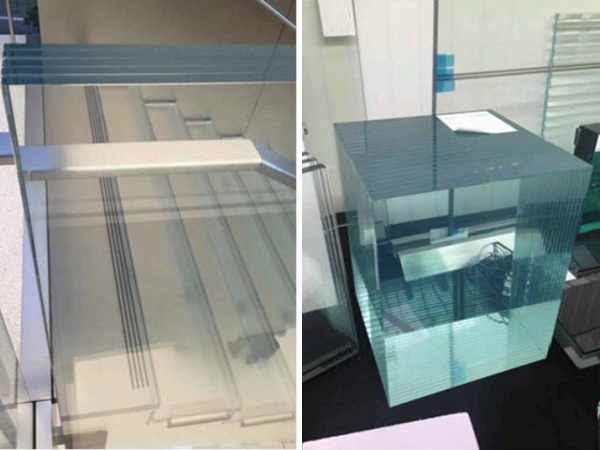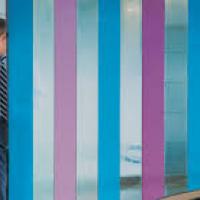Introduction:
For over four thousand years, the lustrous, hard, and inert characteristics of glass, coupled with its transparency, have made it one of the world’s most desirable and most frequently used materials. Glass is used and touched by humans in many of our everyday activities. Glass is included in a multitude of products all around us, such as in windows, doors, skylights, partitions, furniture, shelving, drinkware, cookware, eyeglasses, automotive windows and sunroofs, and food & beverage containers… the list goes on from here.
Glass cleans easily with nonabrasive cleaners including many anti-bacterial cleaners and that is another reason why in the time span of millenniums, glass has helped us through many unfortunate events such as plagues, epidemics, and pandemics. The ability to easily clean and sanitize glass remains true with the COVID-19 outbreak that originated in China in late 2019 and quickly spread worldwide.
This document offers suggested methods for cleaning and sanitizing glass surfaces and is focused on the glass fabricator / processor but is applicable for glass in general. All or portions of these methods can be adopted for use to clean glass used in most glazing applications.
General Background:
Is it safe to receive, unload and process glass received from Vitro during times of elevated concern of viruses and bacteria such as during the pandemic?
- Vitro float glass is produced on a continuous highly automated process where virtually all the glass is made, packaged, and shipped without ever being touched by human hands.
- Raw materials such as sand, arrive by railcar or truck and are automatically unloaded and conveyed to storage silos. Once needed, these materials are automatically conveyed, weighed, and mixed for entry into the glass making thermal reactor.
- The glass thermal reactor operates at over 2,500°F which melts the sand and other raw materials. At the same time the extreme temperature destroys all organic materials, organisms and micro-organisms found with the raw batch materials.
- A continuous ribbon of glass is formed at a given controlled thickness, a stain inhibitor is applied, the ribbon is cut into large sheets, separating powder is applied, glass sheets are packaged and stored utilizing automated equipment without human contact.
- When an order is to be filled, the glass is retrieved from storage and loaded onto a truck via specialized handling equipment designed to avoid human contact with the glass.
- The raw glass does require washing at some point during subsequent processing at the fabricator to remove the separating powder and cutting fluid used during the cut down process.
- It is still a good idea to wash your hands thoroughly and regularly – and avoid touching your face – after handling deliveries.




Protection/Isolation:
Glass is a unique material because glass does not absorb anything, nor does it exude anything but will allow light to enter spaces while providing physical separation and protection. In this way, glass is an ideal material for wall coverings and windows in places that are subject to specific hygiene requirements such as hospitals, hematology, oncology, and geriatric units. Glass can be used as a shield to create a physical barrier between people and can be used in isolation rooms, burn units, sterilization rooms, etc. It can be used in clinics, infirmaries, maternity units, pharmacies, and laboratories.
Glass and glass with specialized coatings such as Vitro’s Clarvista® glass product is an excellent material to use in areas that are damp and thus prone to staining and bacterial and fungal development such as showers and bathrooms, health spas, sports halls, swimming pools, etc. While Clarvista is not an antibacterial coating it can help minimize the potential of these environments of permanently staining / affecting the glass surface.
Glass can help protect people and objects from airborne contaminants. Sneeze guards are one examples of where glass can be used to protect individuals, food, and other merchandise for deli counters, bakery display cases, retail cashiers, registers, checkouts, and service counters from human expelled bacteria and viruses.
Glass allows us to see what is on the other side but safely keeps us separated from potential bacteria and viruses on the other side of the glass.
Bacteria/Virus:
DID YOU KNOW?
Five seconds of contact is enough time to pick up 99% of bacteria from a contaminated surface. Although most micro-organisms are harmless to humans, exposure to some bacteria and viruses can have serious consequences by causing infection or disease. Bacteria and viruses can survive on surfaces such as plastic, stainless steel, benchtops, and glass, among others. These materials can support infectious virus, expelled in droplets, for up to 72 hours. Items such as cellphones and monitor screens, mirrors and glass doors can also support bacteria and viruses.
The amount of time that bacteria and viruses can stay on these surfaces can vary greatly but can last as long as four days depending on variables including location and temperature, according to a study by the Journal of Hospital Infection. This report charted the persistence of the SARS-CoV virus, which is like the virus that causes COVID19. However, the report also notes that over a four-day period, the virus rapidly degrades during this time.
A 2011 Study found that the H1N1 flu virus that caused the 2009 pandemic could be recovered from glass, stainless steel, plastic, and aluminum for up to 48 hours, but most of the virus was gone after nine hours.
To reduce your chance of catching or spreading a virus, frequently clean and disinfect all contact surfaces and objects in your home and office. Fortunately, glass is easily cleaned and disinfected and can be repeatedly cleaned by the methods discussed below while maintaining its original luster and appearance.
Viruses do degrade over time, but you should avoid touching surfaces in shared spaces and if you can’t do that, avoid touching your face afterwards until thoroughly washing your hands.
Machine Cleaning of Glass:
Vitro Technical Document, TD-144 “Machine Washing of Glass” contains Vitro’s recommendations for the normal cleaning of both coated and uncoated glass during the glass fabrication process. Vitro Technical Documents such as this one are available at: https://www.vitroglazings.com/technicalinformation/technical-documents/.
Localized Cleaning of Uncoated Glass Surface:
Vitro float glass (uncoated glass) is a durable product that can be maintained in satisfactory condition by regular cleaning using accepted good glass cleaning practices. Uncoated glass surfaces clean easily with non-abrasive cleaners including diluted bleach and other anti-bacterial cleaners. Glass cleaning recommendations can be referenced in Vitro Technical Documents:
TD-142 “Glass Cleaning Recommendations”
TD-144 “Machine Washing of Glass”
TD-107 “Residue on Glass”
Note that in most cases the coated surface of the glass is captured inside the finished glass product and it is the uncoated surface that is exposed for cleaning. Consult the product manufacturer for coated / uncoated surface locations of your specific product.
Diluted bleach solutions, alcohol solutions containing at least 70% alcohol and most EPAregistered common disinfectants are effective at disinfecting surfaces against viruses, according to the CDC.
A bleach solution can be prepared by mixing five (5) tablespoons (one-third cup) of bleach per gallon of water or four (4) teaspoons of bleach per quart of water. [Per CDC.gov Guidelines] However, caution per the CDC, "never mix bleach with ammonia or any other cleanser". Mixing common cleaners together can create toxic fumes, according to a Live Science report.
For example, when bleach is mixed with an acidic solution, a chemical reaction produces chlorine gas, which can cause irritation of the eyes, throat, and nose. At high concentrations, that gas can cause breathing difficulties and fluid in the lungs, and at very high concentrations it can lead to death, according to the report.
The cleaning procedure immediately below can be used on uncoated glass and Vitro Solarcool® or Vistacool® coated glass products. This would include all Vitro clear and tinted products, monolithic Solarcool® or Vistacool® , and any finished insulating glass unit where the coating is between the layers of glass. For exposed Sungate® and Solarban® low-e coated glass, please see the section: Localized Coated Glass Cleaning Procedure.
Recommended Uncoated and Solarcool® or Vistacool® Coated Glass Cleaning Procedure:
1. Apply diluted bleach solution, alcohol solution, diluted vinegar, or other cleanser to glass either by spraying or using a clean, grit-free microfiber cloth saturated with cleaning solution. Complete coverage of the area to be cleaned is a necessity. For ease in cleaning, it is recommended to clean an area not exceeding 4 - 5 sqft. at a time. When applying cleaning solutions be careful not to damage glazing or insulating unit seals by overgenerous application and comply with the manufacturer's directions on the label for toxicity, handling, and flammability warnings. Some cleaning solutions could potentially interact or damage the sealants used in the manufacturing of IG units. Consult the sealant manufacturer and/or the fenestration product manufacturer for compatibility.
2. Wipe the above cleaning solutions on the glass in a circular motion, applying light to moderate pressure.
3. Rinse the glass surface immediately with generous amounts of clean water, removing the cleaning solution from the glass surface.
4. Using a squeegee or clean, lint-free dry cloth, remove water from the glass surface. Avoid leaving streaks on the surface that dry and can form water deposits.
5. If residue is still evident when viewing the glass surface in reflection, repeat steps 1 through 4.
Important Note: Do Not clean glass while it is exposed to direct sunlight since the cleaning solution can dry on the glass before it can be washed off.
Localized Cleaning of Coated Glass Surfaces:
MSVD coatings such as Sungate and Solarban low-e coated glass are more susceptible to being damaged by scratching than are uncoated glass surfaces. Additional care must be taken during any localized cleaning process to avoid damaging the coating. In addition, these coatings typically involve materials that are more chemically reactive and subject to corrosion and or degradation. Abrasive & aggressive chemical cleaning must be avoided.
The coated surface of Solarban and Sungate lowe coated glass can be damaged by any type of product that contains chlorine or by products that are acidic or basic in pH. Care must be taken to ensure that any chlorine or other acidic/basic products do not accidentally get on the coated glass surface.
Isopropanol (IPA) or an IPA/De-ionized (DI) water mix will work well for cleaning the coated surface. To be sure that the surface is sanitized, the concentration of the solution needs to be at least 70% alcohol, according to the CDC.
Recommended Localized Coated Glass Surface Cleaning Procedure:
1. Apply IPA or IPA/DI water mix by spraying or using a clean, microfiber cloth saturated with cleaning solution. Complete coverage of area to be cleaned is a necessity. For ease in cleaning, it is recommended to clean an area not exceeding 4 - 5 sqft. at a time.
2. Hand cleaning must be done very carefully to avoid coating damage – “patting” the low-e coated surface is recommended, rather than the typical rubbing motion that is commonly used for cleaning uncoated glass.
Vitro always recommends not touching the low-e coated surface unless it is absolutely necessary. Even patting with an IPA solution and clean microfiber cloth, if not done properly, can result in coating damage or streaks left on the coating which could end up as a visual rejection.
Finished Glass & Fenestration Products:
When cleaning finished glass and fenestration products, consult the manufacturer of the product and utilize procedures as directed by the product manufacturer.
Conclusion:
The unique characteristics and properties of glass make it an excellent material choice to use in many scenarios where easy to clean surfaces and/or physical separation is required. Glass can provide clear views, visual transparency, and a decontaminated surface if properly maintained by frequent cleaning and disinfecting. Glass as produced by Vitro does not contain any human expelled bacteria or viruses since our glass making process is completely automated.




























